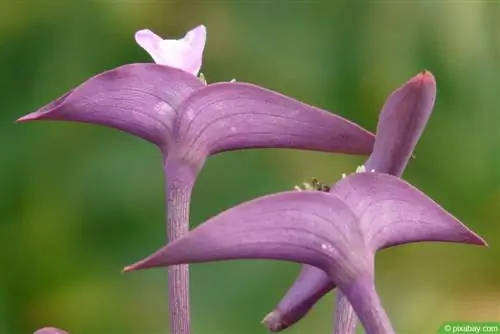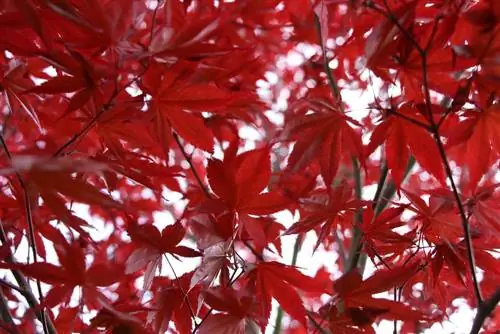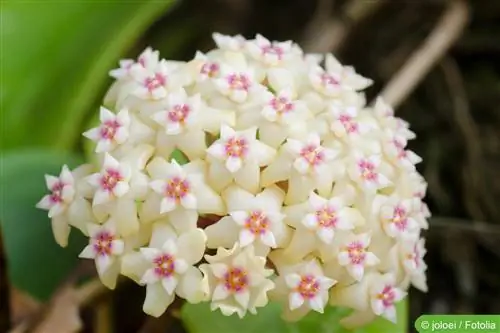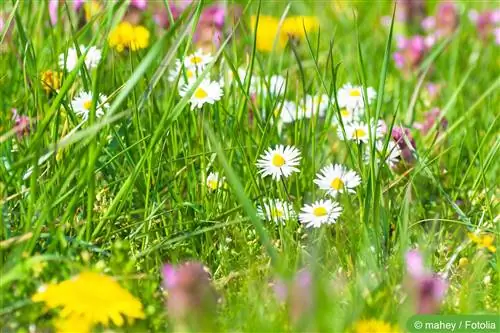- Author admin [email protected].
- Public 2023-12-17 03:39.
- Last modified 2025-01-24 12:45.
In subtropical areas, the plant from the Commelina family is often found in public parks. While the three-master flower, which comes from Mexico, is classified as an invasive plant in Florida, here it offers a striking eye-catcher in planters. The purple-violet shoots are an eye-catcher in the room or winter garden, especially in the cold season you don't want to be without this colorful plant. The red leaf is almost indestructible, only frost and waterlogging can be dangerous to the plant with its interesting leaf pattern.
Location and soil
The three-master flower family is diverse. However, the individual varieties not only vary in their external appearance, but also differ in their location and care requirements. Tradescantia pallida is a plant native to Mexico that requires a full sun location. Even a place in light partial shade should be avoided so that the impressive leaf color does not fade. Pale leaves do not regenerate; only the newly sprouting leaves of the three-master flower show the fascinating grain again. Cultivate the colorful red leaf on a south-facing windowsill or directly on the sunny balcony in summer.
The heat-loving, herbaceous plant is cultivated almost exclusively in containers. Use a loose, humus-rich substrate from the garden. But normal potting soil has also proven effective. Almost more important than the soil consistency is the drainage made of porous material at the bottom of the planter.
Watering and fertilizing
The plant with the purple-violet shoots does not tolerate drought; the root ball must never dry out completely. During the main growing season, water immediately as soon as the top layer of substrate has noticeably dried out. But the Mexican plant also doesn't respond well to standing moisture. You can avoid root rot by watering regularly but in moderation. At the bottom of the bucket, additional lava grit or clay shards ensure that excess water can drain away more quickly. During wintering, the amount of watering is reduced to a minimum.
Tip:
Do not water directly over the foliage of the Mexican beauty. This way you can avoid unsightly leaf spots.
With Tradescantia pallida “Purple Heart” it is important to find the right balance in the supply of nutrients. The substrate of potted plants in particular can only store limited minerals. However, the red leaf is extremely frugal. The crop is fertilized twice a month from March to September with a conventional liquid fertilizer. Halve the amount stated on the packaging. Because too much fertilizer can also lead to an unwanted green coloring of the leaves.
Planting and repotting
The plant, which belongs to the Commelinaceae family, develops long, limp shoots as it gets older. For this reason, it makes sense to cultivate the red leaf directly in a hanging basket. Tradescantia reacts sensitively to temperatures below 8 °C. It is therefore not advisable to plant them outdoors all year round. You can get younger specimens from well-stocked garden stores or directly online. If you want to use a rooted offshoot or give the plant a new planter, you should follow the following tips:
- When repotting, the new pot must be a few centimeters larger than the one previously used.
- Lay a thick layer of lava grit, expanded clay or pottery shards on the bottom.
- Spread a handful of humus-rich soil.
- Remove the plant from the old substrate.
- Insert the plant and fill the cavities with fresh soil.
- Pour vigorously.
Repotting takes place as soon as the roots completely fill the planter. The ideal time for this is between February and March, before the plant has fully awakened from the vegetation break and has begun to form new shoots and leaves.

Cutting
After just a few years, the red leaf increasingly loses its distinctive appearance. The shoots become pale and steadily longer. You can only stop this process to a limited extent. It is therefore advisable to take cuttings regularly. Shorten the long shoots by a few centimeters annually to slow down the aging process. Use a well-sharpened knife instead of scissors. This means that the interface is not crushed, but is cut cleanly. You should remove dead or decayed shoots as close to the ground as possible.
Propagate
The robust plant can be easily propagated from cuttings in spring and summer. This measure is particularly useful because older red-leaf plants have unsightly growth due to their long shoots. Use shoot tips about 15 cm long, which you cut diagonally at the bottom with a sharp knife. If available, you can moisten the end of the shoot with a special rooting powder.
- Let the interface dry for a day.
- Place the cut plant shoot in poor soil.
- The location should be bright, but not sunny.
- The ambient temperature should not fall below 20 °C.
- Keep the substrate moist with a water sprayer.
You can accelerate root formation even without powder: Wrap the container and the cutting with a transparent, slightly perforated film. Red leaf is an extremely heat-loving plant, which is also noticeable in the development of the root system. You can avoid the formation of rot in the soil by removing the film for a few hours every day.
Wintering
Tradescantia pallida is sensitive to cold; the exotic species stops growing at temperatures below 8 °C. At the latest when the outside temperatures drop permanently to this value, you should place the three-masterflower in a frost-proof room. The plant overwinteres at 10° to 15°C. The winter quarters should not be warmer to prevent the plant from rotting. Even staying directly near active radiators can quickly cause problems. Spider mites, for example, prefer this dry environment and attack already weakened houseplants.
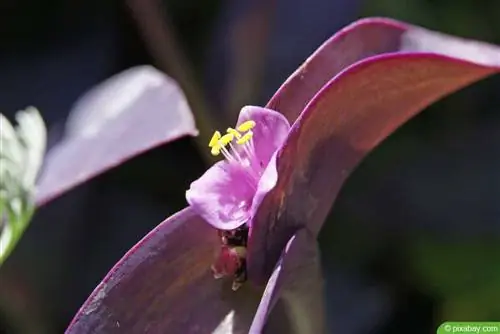
In the cold winter months, the plant is unable to utilize nutrients. Therefore, stop supplying fertilizer from the beginning to mid-September. Watering continues, but at irregular intervals. Check the soil first before adding water. If the top layer of substrate has dried noticeably, it needs to be re-watered. By the way, it is not unusual for the plant to lose some of its foliage in winter. If the location is bright, the temperatures are right and the root ball does not dry out, the plant will produce new leaves in spring.
Diseases and pests
Only a few pests can pose a threat to red leaf. Scale insects and spider mites don't even stop at this exotic plant. Spider mites, which are only a few millimeters in size, can be effectively kept away by taking simple precautions:
- Avoid proximity to heating sources.
- Ensure high humidity.
- Water plants regularly.
Scale insects are a bit more stubborn. It is often recommended to remove the animals using mechanical measures. This is not recommended. Because the female scale insects house the eggs under their shell. If you want to scrape away the insects, the offspring are usually distributed over a large area over the plant. Apply a diluted decoction of nettles or soapy water to control the pests.
Conclusion of the editors
The three-master flower is an interestingly colored houseplant and places relatively few demands on the hobby gardener. While Tradescantia still has its fascinating leaf grain in the first few years, this fades with age. The limp, drooping shoots of the older plants are also anything but decorative. To avoid this problem, you should regularly “rejuvenate” the red leaf with cuttings.
What you should know about Tradescantia pallida soon
- The leaves of the Rotblatt have a bright red color and are covered with fine hairs. In a sunny place the red shines even more strongly.
- But if you place the plant in too much shade, bright red leaves will quickly turn into pale green leaves.
- The flowers of the Rotblatt are pink to pale pink and in its youth the plant has a straight and firm growth.
- As the red leaf gets older, the shoots become longer and find their way over the edge of the pot.
Tip:
The Tradescantia pallidam Setcreasea pallida is therefore best placed in a hanging basket so that the shoots can fully develop. It is important not to cultivate the plant for too long, because as it gets older it quickly becomes unsightly and so you should create offshoots as quickly as possible.
- The preferred location of the red leaf is sunny and dry. The temperatures don't play a big role.
- It therefore likes to overwinter in a slightly warmer place, but the red leaf prefers to be kept cool.
- The red leaf does not require much care. It is best if you water them infrequently. The humus should never dry out completely.
- Fertilization is carried out every 14 days with half of the usual fertilizer.
- If you fertilize them too much, the red leaves turn into simple green leaves.
- The red leaf should be repotted in spring, using normal potting soil.
- To successfully grow offshoots, use cuttings of the red leaf.
- To do this, cut off a piece of 2 cm long from the shoots.
- This is then left to dry for 2 days and then placed in a mixture of peat and sand.
- To achieve the densest growth possible, simply place several cuttings in one pot.

